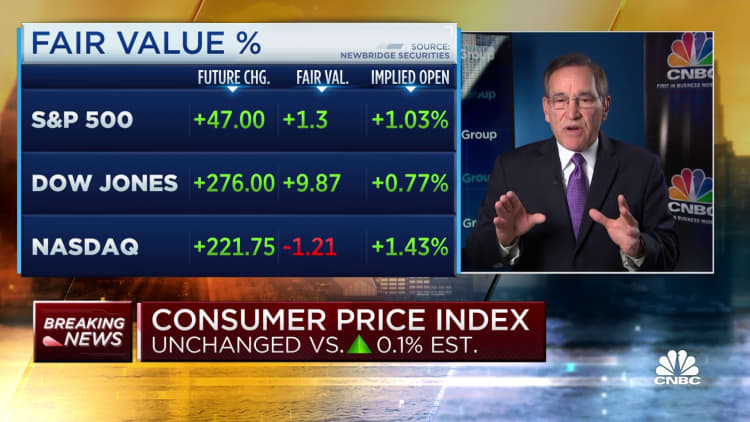A customer holds a fuel nozzle at a Shell gas station in Hercules, California, U.S., on Wednesday, June 22, 2022. President Joe Biden called on Congress to suspend the federal gasoline tax, a largely symbolic move by an embattled president running out of options to ease pump prices weighing on his party’s political prospects. Photographer: David Paul Morris/Bloomberg via Getty Images
Bloomberg | Bloomberg | Getty Images
Inflation declined in October, continuing a broad slowdown as gasoline prices retreated during the month. However, price pressures remain under the surface and it may take a while for them to return to their pre-pandemic baseline, economists said.
“The disinflationary trend is in place,” said Sarah House, senior economist at Wells Fargo Economics. “But we’re getting into a harder part of the cycle.”
In October, the consumer price index increased 3.2% from 12 months earlier, down from 3.7% in September, the U.S. Bureau of Labor Statistics said Tuesday.
The CPI is a key barometer of inflation, measuring how quickly the prices of anything from fruits and vegetables to haircuts and concert tickets are changing across the U.S. economy.
The October reading is a significant improvement on the pandemic-era peak of 9.1% in June 2022 — the highest rate since November 1981. Prices are therefore rising much more slowly than they had been.
“Inflation is slowly but steadily moderating, and all the trend lines look good,” said Mark Zandi, chief economist at Moody’s Analytics. “It feels like by this time next year inflation will be very close to the [Federal Reserve’s] target, and something the American consumer will feel comfortable with.”
The Fed aims for a 2% annual inflation rate over the long term.
Gasoline prices fell in October
Gasoline prices fell 5% in October, according to Tuesday’s CPI report.
Prices for regular-grade gasoline declined by about 33 cents a gallon between Oct. 2 and Oct. 30, from $3.80 a gallon to $3.47, according to the U.S. Energy Information Administration.
They’ve fallen further since then. Average prices at the pump were $3.37 a gallon nationwide as of Nov. 13, according to AAA.
More from Personal Finance:
Try a travel ‘dupe’ to save money on your 2024 trip
‘Sea change’ may be coming for investment advice about 401(k)-to-IRA rollovers
How credit card debt became a $1.08 trillion problem
The monthly pullback is an improvement from August and September, when gasoline was a major contributor to increases in overall inflation readings. In August, for example, prices at the pump spiked 10.6% largely due to dynamics in the market for crude oil, which is refined into gasoline.
“We had a big increase in gasoline prices back in August” and are now seeing an “unwinding of that,” House said.
“What gas prices give us one month, they can taketh away in another,” she added.
What’s happening under the surface
Energy prices can whipsaw inflation readings due to their volatility. Likewise with food.
That’s why economists like to look at a measure that strips out these prices when assessing underlying inflation trends.
This pared-down measure — known as the “core” CPI — fell to an annual rate of 4% in October from 4.1% in September. It’s the smallest 12-month change since September 2021, the BLS said.
Shelter — the average household’s biggest expense — has accounted for more than 70% of the total increase in the core CPI over the past year. Housing inflation declined in October, to 6.7% relative to a year earlier, and has fallen from a peak over 8% in March 2023, according to BLS data.
A continued moderation in housing costs was “the most encouraging aspect” of the October report and should continue to slow in coming months, Zandi said.
“It’s got a long way to go to get back to something I think we’d feel comfortable with,” he added. “But we’re heading in that direction.”

Food inflation was perhaps the one “small blemish” in October, Zandi said. Grocery prices rose 0.3% in October, on a monthly basis, up from 0.1% in September. However, on an annual basis “food at home” inflation increased 2.1% in October, down significantly from a pandemic-era peak over 13% in August 2022, according to BLS data.
Other categories with “notable” increases in the past year include motor vehicle insurance (which increased 19.2%), recreation (3.2%), personal care (6%), and household furnishings and operations (1.7%), according to the BLS.
Why inflation is returning to normal
At a high level, inflationary pressures — which have been felt globally — are due to an imbalance between supply and demand.
Energy prices spiked in early 2022 after Russia invaded Ukraine.
Supply chains were snarled when the U.S. economy restarted during the Covid-19 pandemic, driving up prices for goods. Consumers, flush with cash from government stimulus and staying home for a year, spent liberally. Wages grew at their fastest pace in decades, pushing up business’ labor costs.
Now, those pressures have largely eased, economists said. Supply chains have normalized and the labor market has cooled.
Plus, the Federal Reserve has raised interest rates to their highest level since the early 2000s to slow the economy. This policy tool makes it more expensive for consumers and businesses to borrow, and can therefore tame inflation.
Fed chair Jerome Powell last week said the U.S. still “has a long way to go” before getting back to a sustainable 2% inflation target. Fed officials don’t expect that to happen until 2026.
 EU News Digest Latest News & Updates
EU News Digest Latest News & Updates



